6.8 Western Ballistics Tables From Every Major Ammunition Manufacturer
Congrats! You discovered our in-depth look at 6.8 Western ballistics from the leading ammo manufacturers.
Save time by clicking the links below to jump to your preferred ammo company and find the ballistic specs you need for your favorite 6.8 Western factory load.
6.8 Western Ballistics Charts
Jump to an ammo company producing the relatively new cartridge: Browning | Choice | Winchester
Browning Ammunition Ballistics Charts - 6.8 Western
Jump to a ballistics chart: Browning Long Range Pro Hunter 6.8 Western 175 grain TGK | Browning Max Point 6.8 Western 170 grain Polymer Tip | Browning Silver Series 6.8 Western 170 grain Plated Soft Point
Browning Long Range Pro Hunter 6.8 Western 175 grain TGK Ballistics Chart
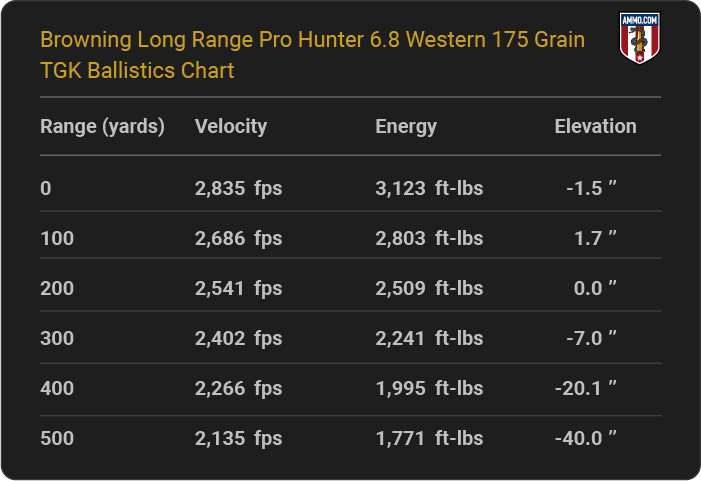
Browning Max Point 6.8 Western 170 grain Polymer Tip Ballistics Chart

Browning Silver Series 6.8 Western 170 grain Plated Soft Point Ballistics Chart
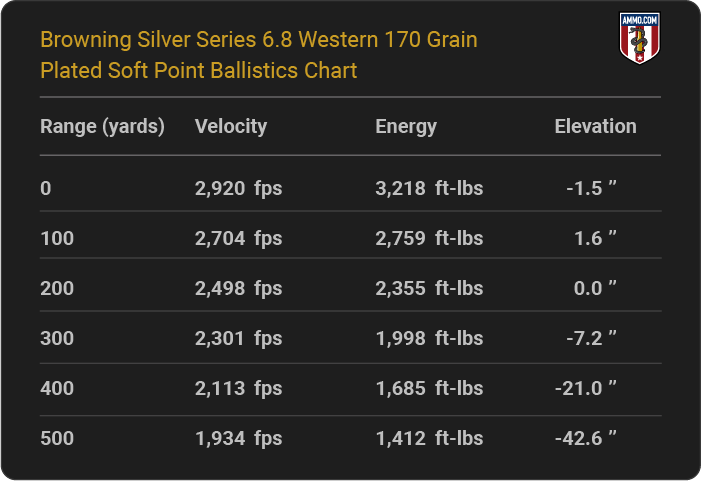
Choice Ammunition Ballistics Charts - 6.8 Western
Jump to a ballistics chart: Choice 6.8 Western 150 grain AccuBond | Choice 6.8 Western 150 grain VLD-H | Choice 6.8 Western 155 grain LRX | Choice 6.8 Western 165 grain AccuBond LR | Choice 6.8 Western 170 grain Ballistic Tip | Choice 6.8 Western 170 grain EOL
Choice 6.8 Western 150 grain AccuBond Ballistics Chart
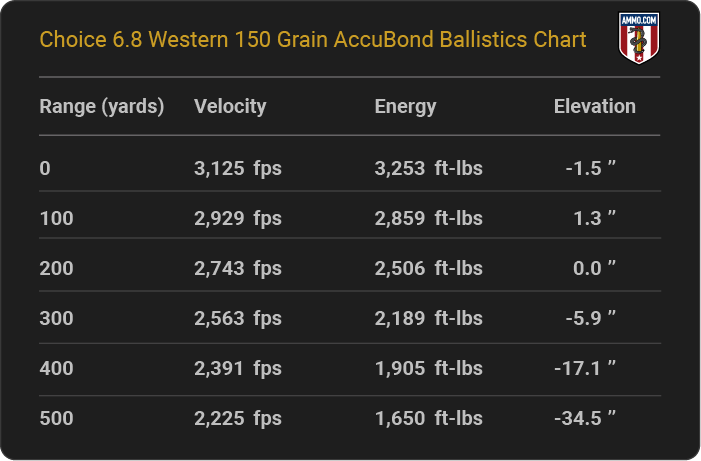
Choice 6.8 Western 150 grain VLD-H Ballistics Chart

Choice 6.8 Western 155 grain LRX Ballistics Chart
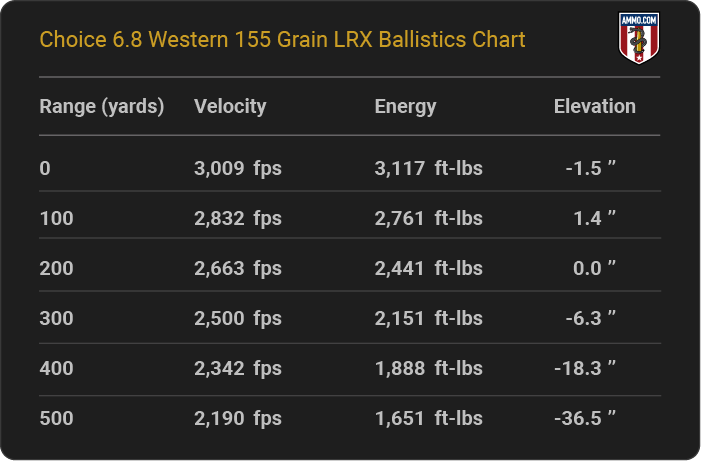
Choice 6.8 Western 165 grain AccuBond LR Ballistics Chart
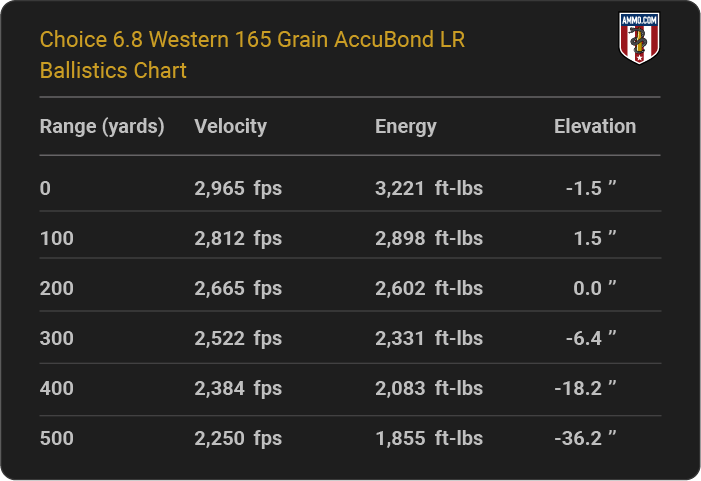
Choice 6.8 Western 170 grain Ballistic Tip Ballistics Chart
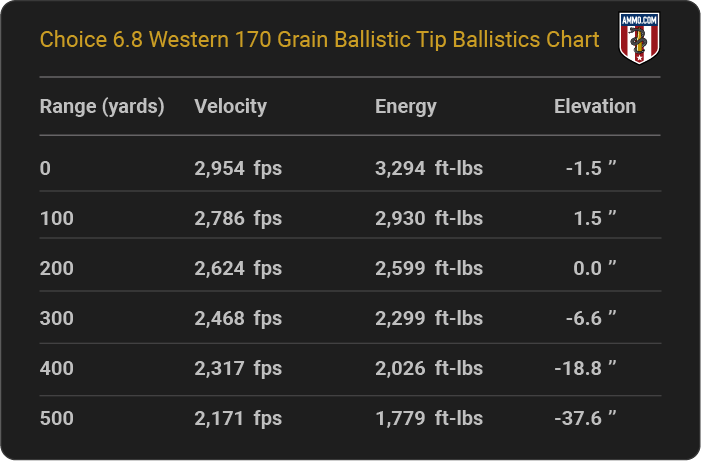
Choice 6.8 Western 170 grain EOL Ballistics Chart
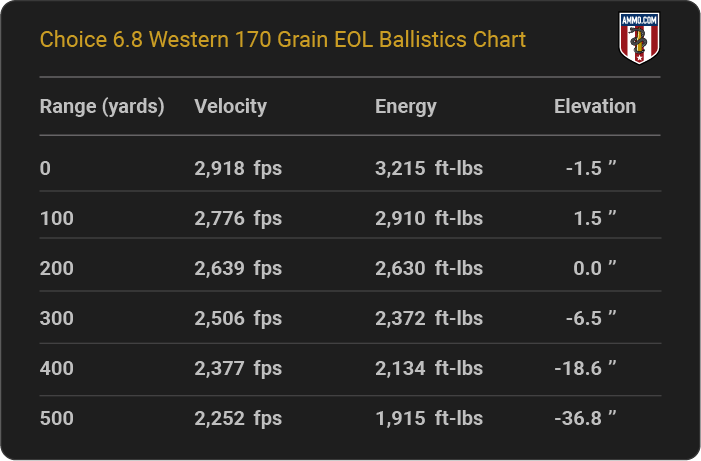
Winchester Ammunition Ballistics Charts - 6.8 Western
Jump to a ballistics chart: Winchester Ballistic Silvertip 6.8 Western 170 grain Polymer Tip | Winchester Copper Impact 6.8 Western 162 grain Polymer Tip | Winchester Expedition Big Game 6.8 Western 165 grain AccuBond LR | Winchester Match 6.8 Western 170 grain MatchKing HPBT | Winchester Power Point 6.8 Western 170 grain SP
Winchester Ballistic Silvertip 6.8 Western 170 grain Polymer Tip Ballistics Chart

Winchester Copper Impact 6.8 Western 162 grain Polymer Tip Ballistics Chart
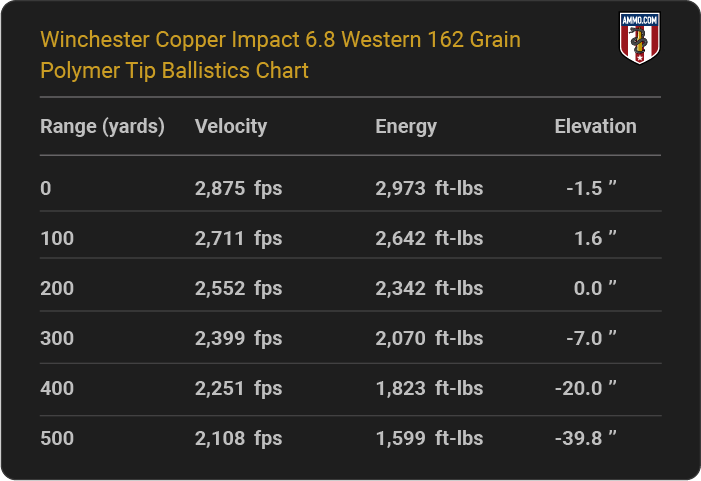
Winchester Expedition Big Game 6.8 Western 165 grain AccuBond LR Ballistics Chart
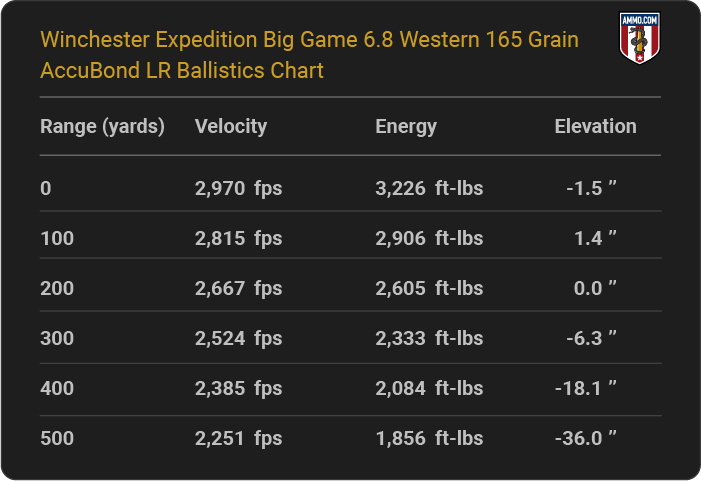
Winchester Match 6.8 Western 170 grain MatchKing HPBT Ballistics Chart
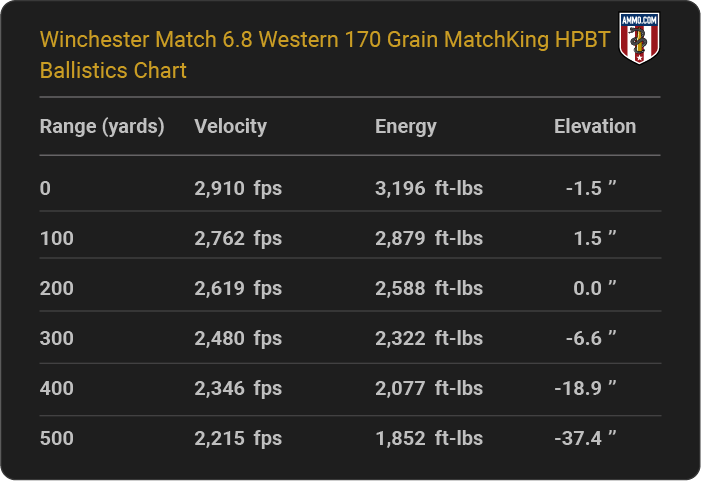
Winchester Power Point 6.8 Western 170 grain SP Ballistics Chart
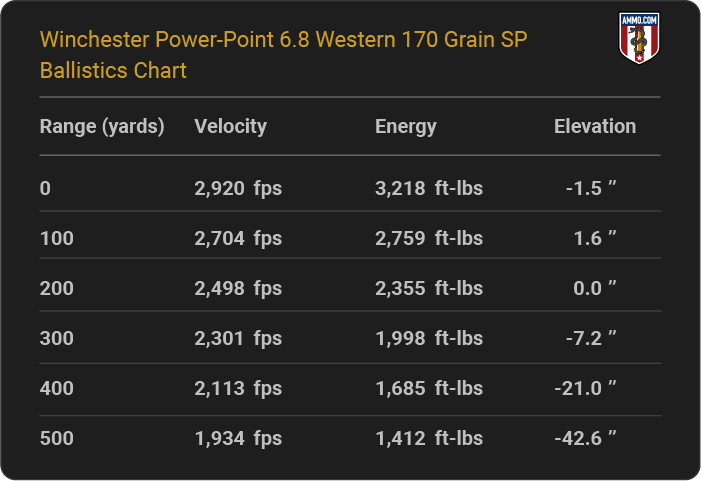
Administrative Note: The information above comes from the manufacturers. The ballistics obtained with your firearm can vary considerably from the advertised ballistics. Also, ballistics can vary from lot to lot with the same brand and load. When manufacturer data were unavailable, ballistics were calculated using a ballistics calculator.
6.8 Western Trajectory Chart
A bullet’s flight path to the target is its trajectory. Long-range shooters measure trajectory in various ways, including inches of bullet drop, milliradians (MIL), and minutes of angle (MOA).
A flat trajectory is preferred for long-range shooting because it requires the shooter to make fewer adjustments to compensate for bullet drop. The 6.5 Creedmoor cartridge and 308 Winchester, with their high ballistic coefficient (BC) projectiles that exhibit relatively little drop at long range, are excellent examples of rifle cartridges with flat trajectories.
Because it doesn’t use high BC bullets, the 270 Winchester, another short-action rifle cartridge, has a trajectory that is not nearly as flat as that of the 6.8 Western cartridge.
The 6.8 Western was conceived as a long-range hunting cartridge. Unsurprisingly, its higher BC bullets are ridiculously flat shooting and minimally affected by wind drift. Most 6.8 Western factory ammo drops less than 40 inches at 500 yards. However, a few loads exhibit nearly 43 inches of bullet drop due to their bullets’ design and heavier weight.
Below is a sample 6.8 Western bullet drop chart that gives a general idea of its trajectory.

Note: The chart above is an example of one 6.8 Western load. Actual ballistic performance may vary depending on bullet weight, lot, barrel length, and environmental conditions while shooting.
6.8 Western Velocity
A bullet’s muzzle velocity is the rate at which it exits the barrel, measured in feet per second (fps).
A longer 6.8 Western rifle barrel produces a higher muzzle velocity, as the exploding propellant has longer to exert its energy against the projectile.
Bullet weight and design significantly affect how much velocity a projectile will exhibit downrange. For example, lighter bullets tend to have higher muzzle velocities than heavier bullets, and polymer-tipped hollow point boat tail projectiles tend to conserve velocity more efficiently than traditional hunting bullets like soft points.
Heavy bullets, like the 175 grain Sierra Tipped GameKing, have a muzzle velocity of 2,835 fps and maintain 2,135 fps out to 500 yards. Meanwhile, lighter bullets like the 150 grain Nosler AccuBond have a muzzle velocity of 3,125 fps and maintain 2,225 fps out to 500 yards.
Handloaded ammunition can achieve higher velocities than factory-loaded ammo, which is just one reason why reloading is so popular for competitive target shooting. While handloading saves some money, producing enough rounds to justify it does require a significant time investment. For safety’s sake, we always recommend following the instructions in your reloading manual, especially when using heavy-for-caliber projectiles.
6.8 Western Kinetic Energy
Muzzle energy is the force a bullet possesses when it exits the rifle barrel. It is measured in foot-pounds (ft-lbs).
Heavier bullets tend to have higher muzzle energy. A projectile’s velocity plays a significant role, which is why lighter projectiles can have a higher muzzle energy than heavier ones. However, heavier projectiles tend to conserve their energy more effectively downrange.
The typical 6.8 Western cartridge has a felt recoil of about 30 ft-lbs in a Weatherby bolt-action rifle. This is less recoil than the 300 PRC (42 ft-lbs), but more than the 6.5 PRC (22 ft-lbs).
This moderate recoil is partly thanks to the kinetic energy of 6.8 Western projectiles. A 150 grain Berger VLD-H has 3,060 ft-lbs of muzzle energy and conserves 1,578 ft-lbs at 500 yards. In contrast, a 170 grain Nosler Ballistic Tip has a muzzle energy of 3,294 ft-lbs and maintains 1,779 ft-lbs of energy out to 500 yards when fired from a typical hunting rifle, like the Browning X-Bolt Western Hunter.
6.8 Western Effective Range
As its name implies, the 6.8 Western was designed for Western hunters pursuing whitetail deer, mule deer, pronghorn, elk, and other big game animals at long range. Depending on the shooter's skill, the 6.8 Western has an effective range for big game animals, such as elk, out to about 700 yards.
Since this caliber bullet maintains over 1,000 ft-lbs of energy out to 1,000 yards, it’s technically capable of ethically harvesting deer at this range. Still, you’ll need to be an expert marksman to make that shot, as it will have nearly 250 inches of bullet drop at that distance.
How Do 6.8 Western Ballistics Compare to Other Rifle Cartridges?
The 6.8 Western is comparable to many other rifle cartridges, such as the 270 WSM (Winchester Short Magnum), 300 Winchester Magnum, 6.5 PRC and 6.5 Creedmoor. But which is the best cartridge for your shooting needs?
Let’s find out!
6.8 Western vs. 300 Win Mag Ballistics Chart
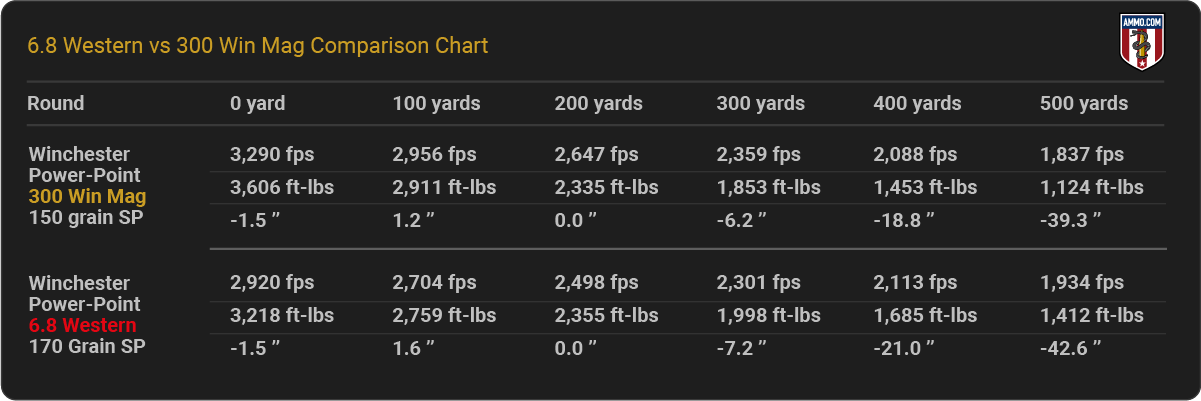
6.8 Western vs. 6.5 PRC Ballistics Chart
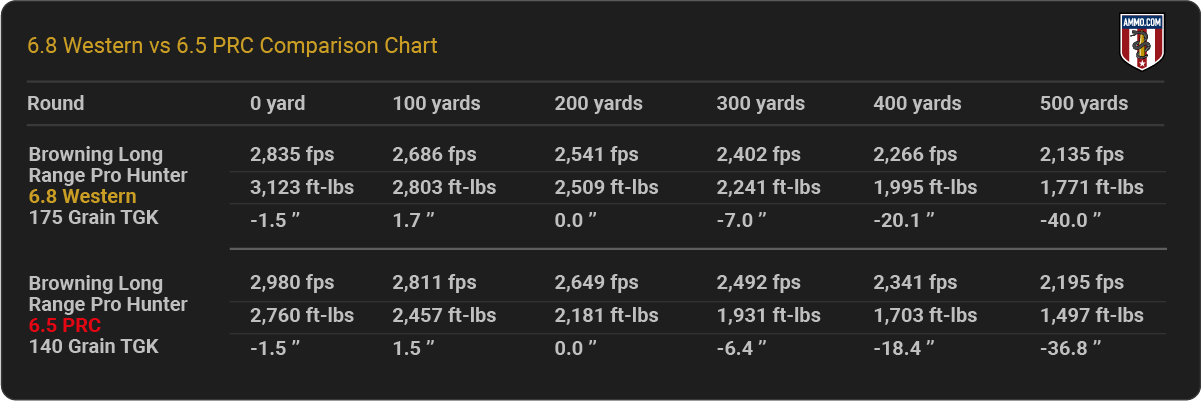
Don’t miss our in-depth 6.8 Western vs. 6.5 PRC comparison.
6.8 Western vs. 6.5 Creedmoor Ballistics Chart
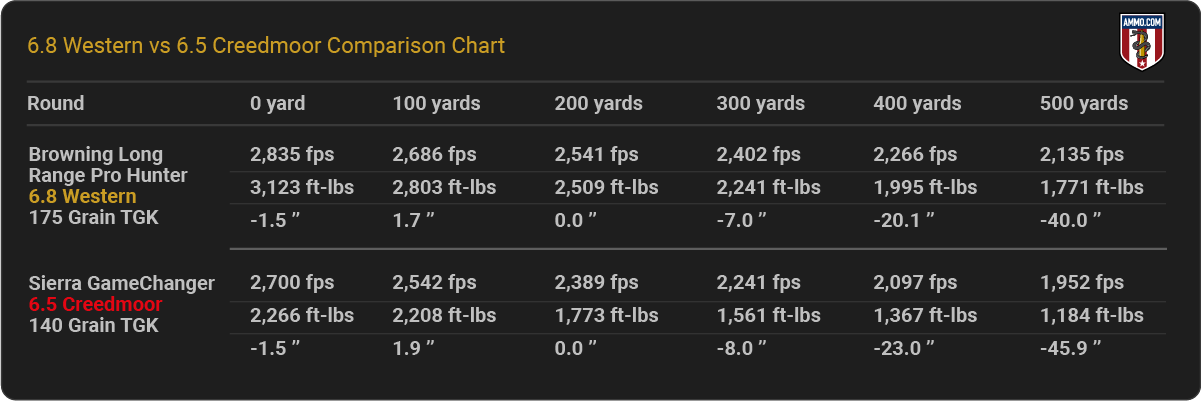
Don’t miss our in-depth 6.8 Western vs. 6.5 Creedmoor comparison.
This article is an integral part of our expansive ballistics chart resources.
Frequently Asked Questions
The team at Ammo.com has gathered and answered some of the most commonly asked questions about 6.8 Western ballistics.
What does a 6.8 Western compare to?
The 6.8 Western compares to the 270 Win, 270 WSM, 6.5 PRC, 7mm PRC, and 300 Win Mag.
What is the maximum effective range of a 6.8 Western?
In the hands of a highly skilled shooter, the maximum effective range of a 6.8 Western for deer hunting is 1,000 yards.
How much does a 6.8 Western drop at 300 yards?
A 6.8 Western will drop about 6.5 inches at 300 yards.
How does the 6.8 Western compare to the 7mm Rem Mag?
The 6.8 Western carries more energy downrange, but the 7mm Rem Mag has a flatter trajectory. Check out our complete comparison here!
Ballistic Charts
- 308 Ballistics Charts
- 6mm ARC Ballistic Charts
- 10mm Auto Ballistics Charts
- 224 Valkyrie Ballistics Charts
- 204 Ruger Ballistics Charts
- 30-30 Ballistics Charts
- 6.8 SPC Ballistics Charts
- 350 Legend Ballistics Charts
- 300 Blackout Ballistics Charts
- FN 5.7x28 Ballistic Charts
- 7.62x39 Ballistics Charts
- 22 Creedmoor Ballistics Charts
- 300 PRC Ballistics Charts
- .360 Buckhammer Ballistics Charts
- 8.6 Blackout Ballistics Charts
- 30-06 Ballistics Charts
- 44 Magnum Ballistics Charts
- 7mm-08 Ballistics Charts
- 7mm Rem Mag Ballistics Charts
- 300 Win Mag Ballistics Charts
- 270 Win Ballistics Charts
- 45 Long Colt Ballistics Charts
- 6.5 Creedmoor Ballistics Charts
- 40 S&W Ballistics Charts
- 243 Win Ballistics Charts
- 357 Magnum Ballistics Charts
- 380 ACP Ballistics Charts
- 45 ACP Ballistics Charts
- 223 Rem Ballistics Charts
- 450 Bushmaster Ballistics Charts
- 400 Legend Ballistics Charts
- 5.56 Ballistics Charts
- 9mm Ballistics Charts
- 28 Nosler Ballistics Charts
- 45-70 Ballistics Charts
- 6.5 PRC Ballistics Charts
- 22-250 Ballistics Charts
- 22 Hornet Ballistics Charts
- 7mm PRC Ballistics Charts
- 22 ARC Ballistics Charts
- 6.8 Western Ballistics Charts
